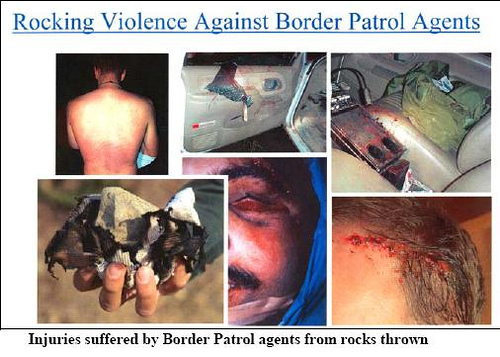See, earlier, by James Fulford: CNN Doesn't Want To Know About The Fence That Worked—But We Know, And Have For Years
[VDARE.com Editor Peter Brimelow writes: From my 1995 (!) book Alien Nation, Chapter 13, Doing The Right Thing? The Morality Of Immigration, a description of the border situation pre-1995, when I visited the border near San Diego. (Alien Nation is available on Kindle for less than 5 dollars for anyone who wants to Read The Whole Thing. Or you can read it for free via Unz.com). Subsequently, a wall was built and has proved a great success. Walls work. The politicians just don't want to know.]
![https://images-na.ssl-images-amazon.com/images/I/51K2E8merfL._SY346_.jpg]() I don't know if you would call it the Greatest Show on Earth. But it's certainly one of the most remarkable spectacles in the United States. Every sundown at Virginia Street in San Ysidro, over by Stewart's Bridge across the Tijuana River or at any of a number of other jumping-off points along the Chula Vista sector of the U.S.-Mexican border south of San Diego, you can see crowds of illegal immigrants gathering—or "staging," in the language of the U.S. Border Patrol—waiting for dark so they can cross.
I don't know if you would call it the Greatest Show on Earth. But it's certainly one of the most remarkable spectacles in the United States. Every sundown at Virginia Street in San Ysidro, over by Stewart's Bridge across the Tijuana River or at any of a number of other jumping-off points along the Chula Vista sector of the U.S.-Mexican border south of San Diego, you can see crowds of illegal immigrants gathering—or "staging," in the language of the U.S. Border Patrol—waiting for dark so they can cross.
They are already illegal because many of these staging points are well within U.S. territory. The Border Patrol has been compelled to fall back to a more defensible line. The routine is so well established that vendors regularly arrive to sell the illegals food and drink. It is so blatant that they will openly light fires to keep warm.
The Border Patrol knows to within seconds each evening when the rush will start. It is so predictable that it could be shown live on the nightly TV news—if the national networks in faraway New York City were interested. And up on the ridge, despite the dark, the Border Patrol officers watching through the powerful truck-mounted infrared scope swiveling on its twenty-foot camera tower can quite clearly see any illegal crossings within a five-mile range. They show up as ghostly white figures on a softly glowing screen.
![http://www.limitstogrowth.org/WEB-Graphics/BorderAgentsRockInjuries.jpg]() Usually, the illegals start to trickle across in small groups of two or three, dodging through the brush of no-man's-land. Occasionally, however, a large group will simply charge isolated officers and overwhelm them. The Border Patrol calls this a "banzai." If objects are thrown at the officers, as they frequently are on the border, this is "getting rocked."
Usually, the illegals start to trickle across in small groups of two or three, dodging through the brush of no-man's-land. Occasionally, however, a large group will simply charge isolated officers and overwhelm them. The Border Patrol calls this a "banzai." If objects are thrown at the officers, as they frequently are on the border, this is "getting rocked."
The Border Patrol knows, also, that most of the illegals will get through. There are just too many illegals and too few officers. In 1992, a total of 565,581 illegals were caught crossing this fourteen-mile sector of the border—an average of over 1,500 a night, nearly half of all the apprehensions along the twenty-five-hundred-mile U.S.-Mexican frontier. (By contrast, along the three-thousand-mile U.S.-Canadian frontier in 1992, there were just over 15,000 apprehensions.)
Just over a thousand officers are assigned to the San Diego sector. They reckon they catch about one illegal in three.
AMERICA—COLONY OF THE WORLD?
People respond to this spectacle on the border in very different ways. For example, The New York Times's A. M. Rosenthal wrote another column about immigration in early 1993. Once again, he recounted the story of his illegal-alien father. He went on:
Ever since I have detested the word "alien." It should be saved for creatures that jump out of bellies in movies. Immigrant is a better word, historically proud.
Decades later, prowling along a river with Texas rangers to see them catch crossing Mexicans, I stopped and sat on the ground. I said that's enough—I am one of them, the wetbacks, and not them, the hunters.[ Aliens: Let Them Work, by A. M. Rosenthal, February 9, 1993]
I, of course, was for years a legally resident alien. And it seems to me the United States had a perfect right to call me anything it wants.
There can be no doubt that many of Rosenthal's readers would have thrilled to this display of his exquisite sensibility. But, privately, I didn't.
As a matter of fact, it struck me as so self-indulgent as to disqualify him from attempting to influence the destiny of a nation. He reminded me of the captain of a supertanker, on the bridge and responsible for steering his ship through shoals, getting drunk on his own self-righteousness.
My own response to the spectacle on the border: mounting irritation with the immigration enthusiasts who insist dogmatically, gloatingly, that the illegal influx cannot be controlled. Quite obviously, it can—especially by the country that put a man on the moon. What is missing is not the way. It is the will.
The Border Patrol has fewer than four thousand officers. (Another thousand were promised in the 1990 Immigration Act, but the funds were never appropriated.) The service is so underfunded that it cannot field enough vehicles for the officers it does have. They have to chase the illegals on foot, trying to follow directions called to them over the radio by the infrared-scope operator. (And there's only one such scope.) They are so hemmed about with regulations that, for example, your young Border Patrol guide will calmly turn his jeep out of the immediate battle zone for a few minutes, onto the 1-5 freeway, and immediately point out squads of illegals marching brazenly northward on the hard shoulder. The illegals know that arrest attempts have been forbidden there, supposedly for fear of accidents.
Incredibly, as late as 1991 there was not even a frontier fence in the San Diego sector, nor any lights. Illegals drove across the border in vehicles, several abreast. The U.S. government had to be literally shamed into action: Muriel Watson, a Border Patrol officer's widow, organized a monthly demonstration whereby enraged private citizens began driving to the border at night and simultaneously switching on their cars' headlights. After her fourth "Light Up the Border" demonstration, Watson was interviewed on Roger Hedgecock's top-rated radio talk show on San Diego's KSDO and achieved national fame.
Yet seeing the border also brings home how easy securing it could be. The new nineteen-mile fence from the coast—a clumsy metal barrier, you can see where the illegals dig under it daily like raccoons—ends in the Otay Mesa, a cruel-looking desert wall. This is terrain you could die in. Some illegals have. Only an estimated 200 to 250 miles of the U.S.-Mexican border are thought to be passable at all. The problem is far from infinite.
Similarly, when the dogs start barking in the houses just below while you are watching through the infrared scope, you can actually see the ghostly illegals and their guides filing down the canyons suddenly hesitate and stop. Which provokes a simple question: Why doesn't the Border Patrol use dogs?
This shocks your young guide. "Have you ever seen a police dog in a crowd?" he says. He thinks the solution, reasonably enough, is to hire more Border Patrol officers.
Well, yes. But, thinking about his reaction, several questions occur. Such as: why is it acceptable to use police dogs on American citizens but not on foreign invaders? And: the dogs don't have to eat the illegals. They could be trained differently, to hold them—or just to track them.
But the real answer is something your guide has told you earlier. The illegals (or at least their professional smugglers) are acutely attuned to U.S. Border Patrol activities. They even time their crossings to coincide with the duty shifts of officers they regard as lazy.
To paraphrase the ads for the movie Field of Dreams: if these people hear dogs baying, they will not come.
![https://images-na.ssl-images-amazon.com/images/I/819dtil125L.jpg]() Apparently, no one has worked this out. Which tells you how profound is the paralysis that has overcome that once-fabled Yankee ingenuity in the face of this most straightforward of technical problems.
Apparently, no one has worked this out. Which tells you how profound is the paralysis that has overcome that once-fabled Yankee ingenuity in the face of this most straightforward of technical problems.
It is a paralysis that stems from a reflexive, masochistic submission, at a deep psychological level, to the demands of others—a sure sign that the United States has become "A Colony of the World," to appropriate the title of the recent book on the phenomenon by former senator Eugene McCarthy, who frankly says that he now regrets co-sponsoring and voting for the Immigration Act in 1965.
Mexican-American ingenuity may be in better shape. In late 1993, El Paso Border Patrol sector chief Silvestre Reyes organized "Operation Blockade," deploying as many of his agents as possible right on the border around the clock. The aim was to deter illegals from entering, rather than intercepting them after entry—the standard Border Patrol procedure, whether to economize on force or because only big apprehension numbers scare money out of Congress.
It worked. Apprehensions, a proxy for illegal border crossings, fell by three quarters or more. Crimes in which illegal immigrants specialize also fell—auto theft was down by half. To Hispanic critics, Reyes responded memorably:
Are we supposed to be less American because we are Hispanic? I don't think so. I've fought for this country. I've committed my career to controlling its borders. [El Paso Shows How to Defend the Line, by Daniel James, Human Events, February 11, 1994]
Peter Brimelow [Email him] is the editor of VDARE.com. His best-selling book, Alien Nation: Common Sense About America’s Immigration Disaster, is now available in Kindle format. Follow Peter Brimelow on Twitter.





 Usually, the illegals start to trickle across in small groups of two or three,
Usually, the illegals start to trickle across in small groups of two or three,  Apparently, no one has worked this out. Which tells you how profound is the paralysis that has overcome that once-fabled Yankee ingenuity in the face of this most straightforward of technical problems.
Apparently, no one has worked this out. Which tells you how profound is the paralysis that has overcome that once-fabled Yankee ingenuity in the face of this most straightforward of technical problems.








